Social Infrastructure Standards and Commercial Facilities Analysis
VerifiedAdded on 2021/06/30
|12
|2068
|319
Report
AI Summary
This report, authored by Jasneet Singh Naru, comprehensively examines social infrastructure standards and commercial facilities. It begins by defining infrastructure and its importance in economic development, referencing World Bank reports and the Planning Commission of India. The report then classifies infrastructure into physical, social, and commercial categories according to UDPFI guidelines. A detailed analysis of social infrastructure components such as education (including norms for pre-primary to higher education), healthcare, recreation facilities, security services (fire and police), and distributive services is provided. The report emphasizes the importance of adequate social infrastructure in enhancing the quality of life, attracting investment, and fostering strong communities. It concludes by highlighting the role of government in maintaining standards and providing services to meet the diverse needs of the population. The report references various government publications and guidelines, including those from the World Bank, WHO, and the Ministry of Urban Development.
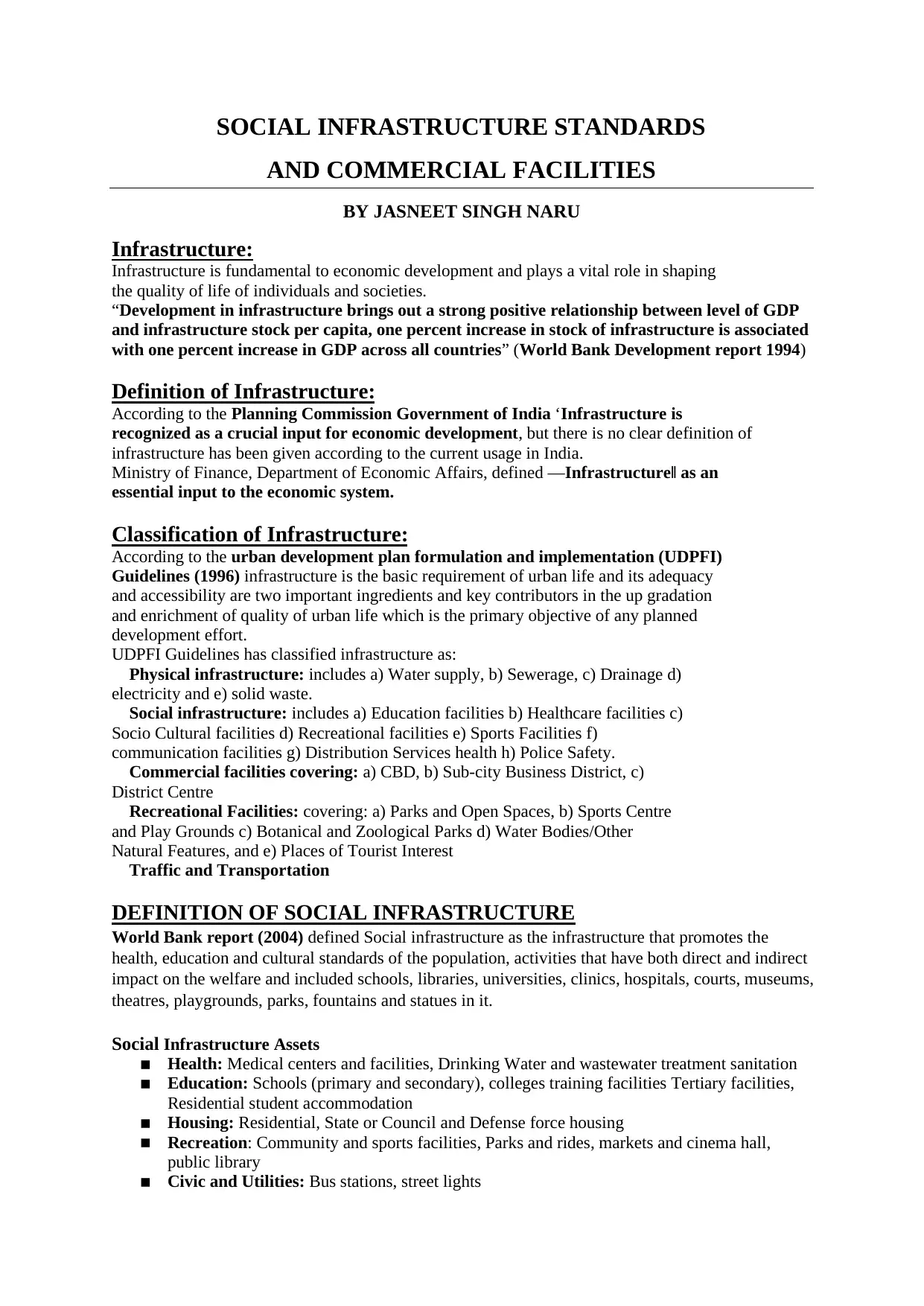
SOCIAL INFRASTRUCTURE STANDARDS
AND COMMERCIAL FACILITIES
BY JASNEET SINGH NARU
Infrastructure:
Infrastructure is fundamental to economic development and plays a vital role in shaping
the quality of life of individuals and societies.
“Development in infrastructure brings out a strong positive relationship between level of GDP
and infrastructure stock per capita, one percent increase in stock of infrastructure is associated
with one percent increase in GDP across all countries” (World Bank Development report 1994)
Definition of Infrastructure:
According to the Planning Commission Government of India ‘Infrastructure is
recognized as a crucial input for economic development, but there is no clear definition of
infrastructure has been given according to the current usage in India.
Ministry of Finance, Department of Economic Affairs, defined ―Infrastructure‖ as an
essential input to the economic system.
Classification of Infrastructure:
According to the urban development plan formulation and implementation (UDPFI)
Guidelines (1996) infrastructure is the basic requirement of urban life and its adequacy
and accessibility are two important ingredients and key contributors in the up gradation
and enrichment of quality of urban life which is the primary objective of any planned
development effort.
UDPFI Guidelines has classified infrastructure as:
Physical infrastructure: includes a) Water supply, b) Sewerage, c) Drainage d)
electricity and e) solid waste.
Social infrastructure: includes a) Education facilities b) Healthcare facilities c)
Socio Cultural facilities d) Recreational facilities e) Sports Facilities f)
communication facilities g) Distribution Services health h) Police Safety.
Commercial facilities covering: a) CBD, b) Sub-city Business District, c)
District Centre
Recreational Facilities: covering: a) Parks and Open Spaces, b) Sports Centre
and Play Grounds c) Botanical and Zoological Parks d) Water Bodies/Other
Natural Features, and e) Places of Tourist Interest
Traffic and Transportation
DEFINITION OF SOCIAL INFRASTRUCTURE
World Bank report (2004) defined Social infrastructure as the infrastructure that promotes the
health, education and cultural standards of the population, activities that have both direct and indirect
impact on the welfare and included schools, libraries, universities, clinics, hospitals, courts, museums,
theatres, playgrounds, parks, fountains and statues in it.
Social Infrastructure Assets
▪ Health: Medical centers and facilities, Drinking Water and wastewater treatment sanitation
▪ Education: Schools (primary and secondary), colleges training facilities Tertiary facilities,
Residential student accommodation
▪ Housing: Residential, State or Council and Defense force housing
▪ Recreation: Community and sports facilities, Parks and rides, markets and cinema hall,
public library
▪ Civic and Utilities: Bus stations, street lights
AND COMMERCIAL FACILITIES
BY JASNEET SINGH NARU
Infrastructure:
Infrastructure is fundamental to economic development and plays a vital role in shaping
the quality of life of individuals and societies.
“Development in infrastructure brings out a strong positive relationship between level of GDP
and infrastructure stock per capita, one percent increase in stock of infrastructure is associated
with one percent increase in GDP across all countries” (World Bank Development report 1994)
Definition of Infrastructure:
According to the Planning Commission Government of India ‘Infrastructure is
recognized as a crucial input for economic development, but there is no clear definition of
infrastructure has been given according to the current usage in India.
Ministry of Finance, Department of Economic Affairs, defined ―Infrastructure‖ as an
essential input to the economic system.
Classification of Infrastructure:
According to the urban development plan formulation and implementation (UDPFI)
Guidelines (1996) infrastructure is the basic requirement of urban life and its adequacy
and accessibility are two important ingredients and key contributors in the up gradation
and enrichment of quality of urban life which is the primary objective of any planned
development effort.
UDPFI Guidelines has classified infrastructure as:
Physical infrastructure: includes a) Water supply, b) Sewerage, c) Drainage d)
electricity and e) solid waste.
Social infrastructure: includes a) Education facilities b) Healthcare facilities c)
Socio Cultural facilities d) Recreational facilities e) Sports Facilities f)
communication facilities g) Distribution Services health h) Police Safety.
Commercial facilities covering: a) CBD, b) Sub-city Business District, c)
District Centre
Recreational Facilities: covering: a) Parks and Open Spaces, b) Sports Centre
and Play Grounds c) Botanical and Zoological Parks d) Water Bodies/Other
Natural Features, and e) Places of Tourist Interest
Traffic and Transportation
DEFINITION OF SOCIAL INFRASTRUCTURE
World Bank report (2004) defined Social infrastructure as the infrastructure that promotes the
health, education and cultural standards of the population, activities that have both direct and indirect
impact on the welfare and included schools, libraries, universities, clinics, hospitals, courts, museums,
theatres, playgrounds, parks, fountains and statues in it.
Social Infrastructure Assets
▪ Health: Medical centers and facilities, Drinking Water and wastewater treatment sanitation
▪ Education: Schools (primary and secondary), colleges training facilities Tertiary facilities,
Residential student accommodation
▪ Housing: Residential, State or Council and Defense force housing
▪ Recreation: Community and sports facilities, Parks and rides, markets and cinema hall,
public library
▪ Civic and Utilities: Bus stations, street lights
Paraphrase This Document
Need a fresh take? Get an instant paraphrase of this document with our AI Paraphraser
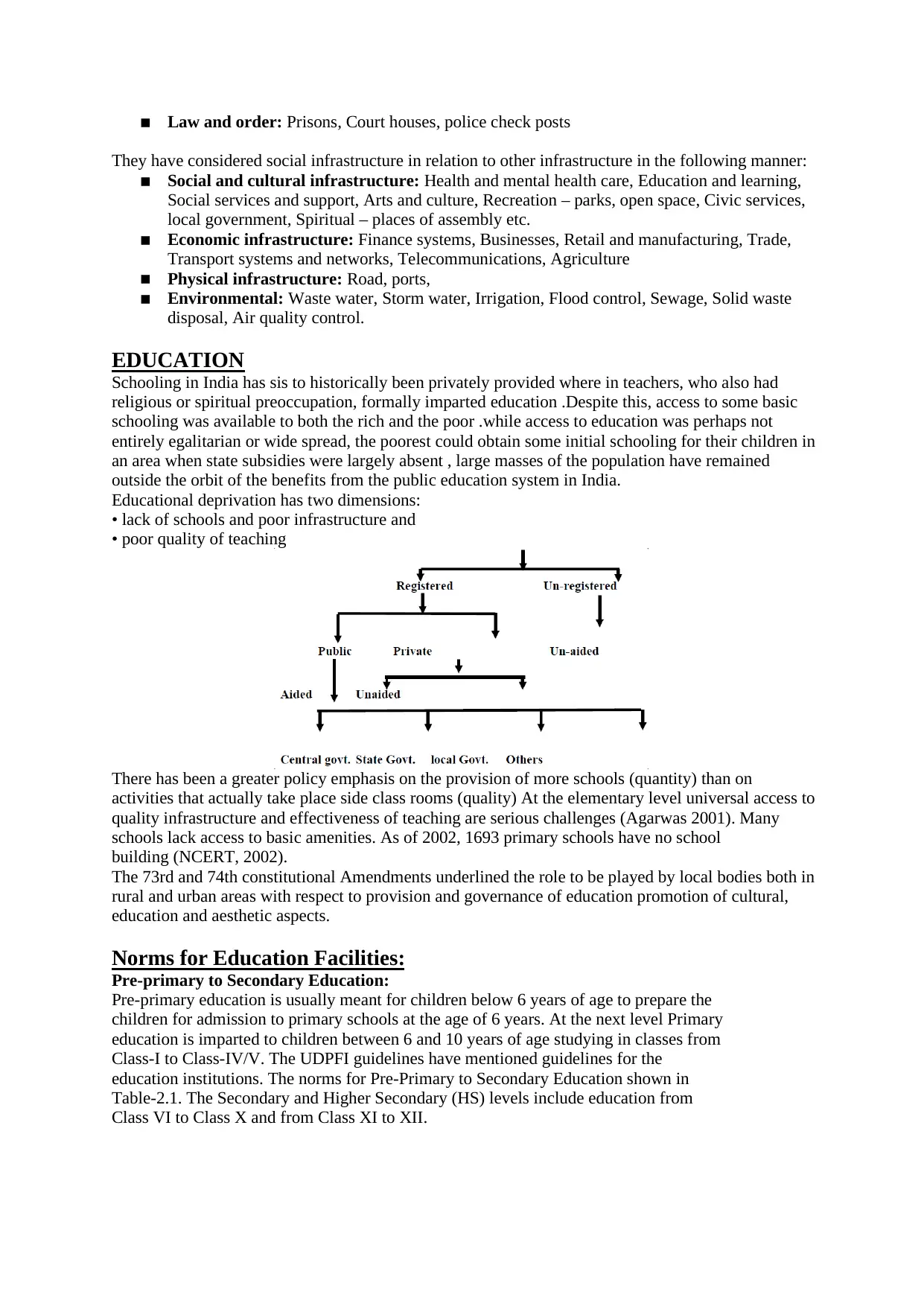
▪ Law and order: Prisons, Court houses, police check posts
They have considered social infrastructure in relation to other infrastructure in the following manner:
▪ Social and cultural infrastructure: Health and mental health care, Education and learning,
Social services and support, Arts and culture, Recreation – parks, open space, Civic services,
local government, Spiritual – places of assembly etc.
▪ Economic infrastructure: Finance systems, Businesses, Retail and manufacturing, Trade,
Transport systems and networks, Telecommunications, Agriculture
▪ Physical infrastructure: Road, ports,
▪ Environmental: Waste water, Storm water, Irrigation, Flood control, Sewage, Solid waste
disposal, Air quality control.
EDUCATION
Schooling in India has sis to historically been privately provided where in teachers, who also had
religious or spiritual preoccupation, formally imparted education .Despite this, access to some basic
schooling was available to both the rich and the poor .while access to education was perhaps not
entirely egalitarian or wide spread, the poorest could obtain some initial schooling for their children in
an area when state subsidies were largely absent , large masses of the population have remained
outside the orbit of the benefits from the public education system in India.
Educational deprivation has two dimensions:
• lack of schools and poor infrastructure and
• poor quality of teaching
There has been a greater policy emphasis on the provision of more schools (quantity) than on
activities that actually take place side class rooms (quality) At the elementary level universal access to
quality infrastructure and effectiveness of teaching are serious challenges (Agarwas 2001). Many
schools lack access to basic amenities. As of 2002, 1693 primary schools have no school
building (NCERT, 2002).
The 73rd and 74th constitutional Amendments underlined the role to be played by local bodies both in
rural and urban areas with respect to provision and governance of education promotion of cultural,
education and aesthetic aspects.
Norms for Education Facilities:
Pre-primary to Secondary Education:
Pre-primary education is usually meant for children below 6 years of age to prepare the
children for admission to primary schools at the age of 6 years. At the next level Primary
education is imparted to children between 6 and 10 years of age studying in classes from
Class-I to Class-IV/V. The UDPFI guidelines have mentioned guidelines for the
education institutions. The norms for Pre-Primary to Secondary Education shown in
Table-2.1. The Secondary and Higher Secondary (HS) levels include education from
Class VI to Class X and from Class XI to XII.
They have considered social infrastructure in relation to other infrastructure in the following manner:
▪ Social and cultural infrastructure: Health and mental health care, Education and learning,
Social services and support, Arts and culture, Recreation – parks, open space, Civic services,
local government, Spiritual – places of assembly etc.
▪ Economic infrastructure: Finance systems, Businesses, Retail and manufacturing, Trade,
Transport systems and networks, Telecommunications, Agriculture
▪ Physical infrastructure: Road, ports,
▪ Environmental: Waste water, Storm water, Irrigation, Flood control, Sewage, Solid waste
disposal, Air quality control.
EDUCATION
Schooling in India has sis to historically been privately provided where in teachers, who also had
religious or spiritual preoccupation, formally imparted education .Despite this, access to some basic
schooling was available to both the rich and the poor .while access to education was perhaps not
entirely egalitarian or wide spread, the poorest could obtain some initial schooling for their children in
an area when state subsidies were largely absent , large masses of the population have remained
outside the orbit of the benefits from the public education system in India.
Educational deprivation has two dimensions:
• lack of schools and poor infrastructure and
• poor quality of teaching
There has been a greater policy emphasis on the provision of more schools (quantity) than on
activities that actually take place side class rooms (quality) At the elementary level universal access to
quality infrastructure and effectiveness of teaching are serious challenges (Agarwas 2001). Many
schools lack access to basic amenities. As of 2002, 1693 primary schools have no school
building (NCERT, 2002).
The 73rd and 74th constitutional Amendments underlined the role to be played by local bodies both in
rural and urban areas with respect to provision and governance of education promotion of cultural,
education and aesthetic aspects.
Norms for Education Facilities:
Pre-primary to Secondary Education:
Pre-primary education is usually meant for children below 6 years of age to prepare the
children for admission to primary schools at the age of 6 years. At the next level Primary
education is imparted to children between 6 and 10 years of age studying in classes from
Class-I to Class-IV/V. The UDPFI guidelines have mentioned guidelines for the
education institutions. The norms for Pre-Primary to Secondary Education shown in
Table-2.1. The Secondary and Higher Secondary (HS) levels include education from
Class VI to Class X and from Class XI to XII.
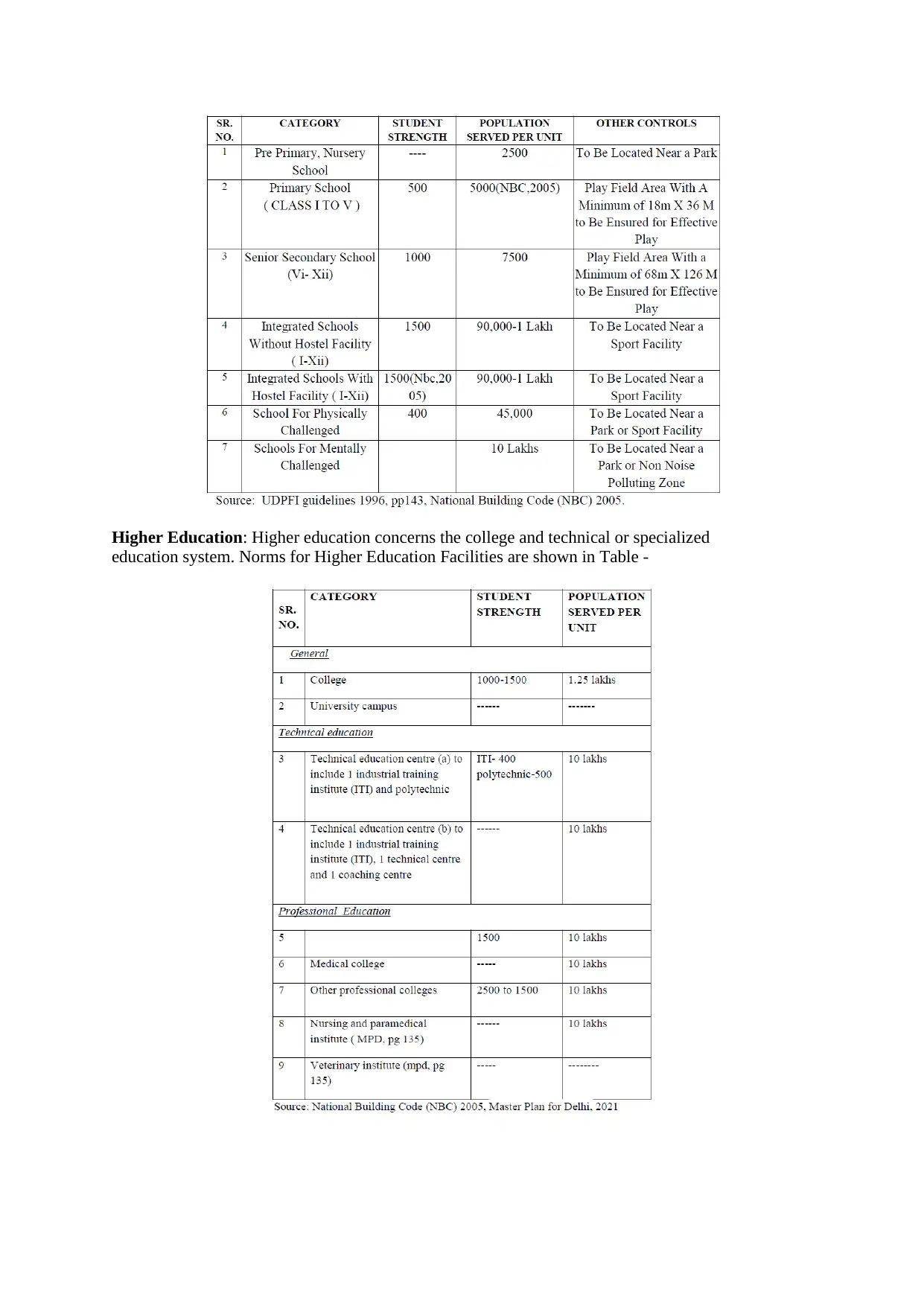
Higher Education: Higher education concerns the college and technical or specialized
education system. Norms for Higher Education Facilities are shown in Table -
education system. Norms for Higher Education Facilities are shown in Table -
⊘ This is a preview!⊘
Do you want full access?
Subscribe today to unlock all pages.

Trusted by 1+ million students worldwide
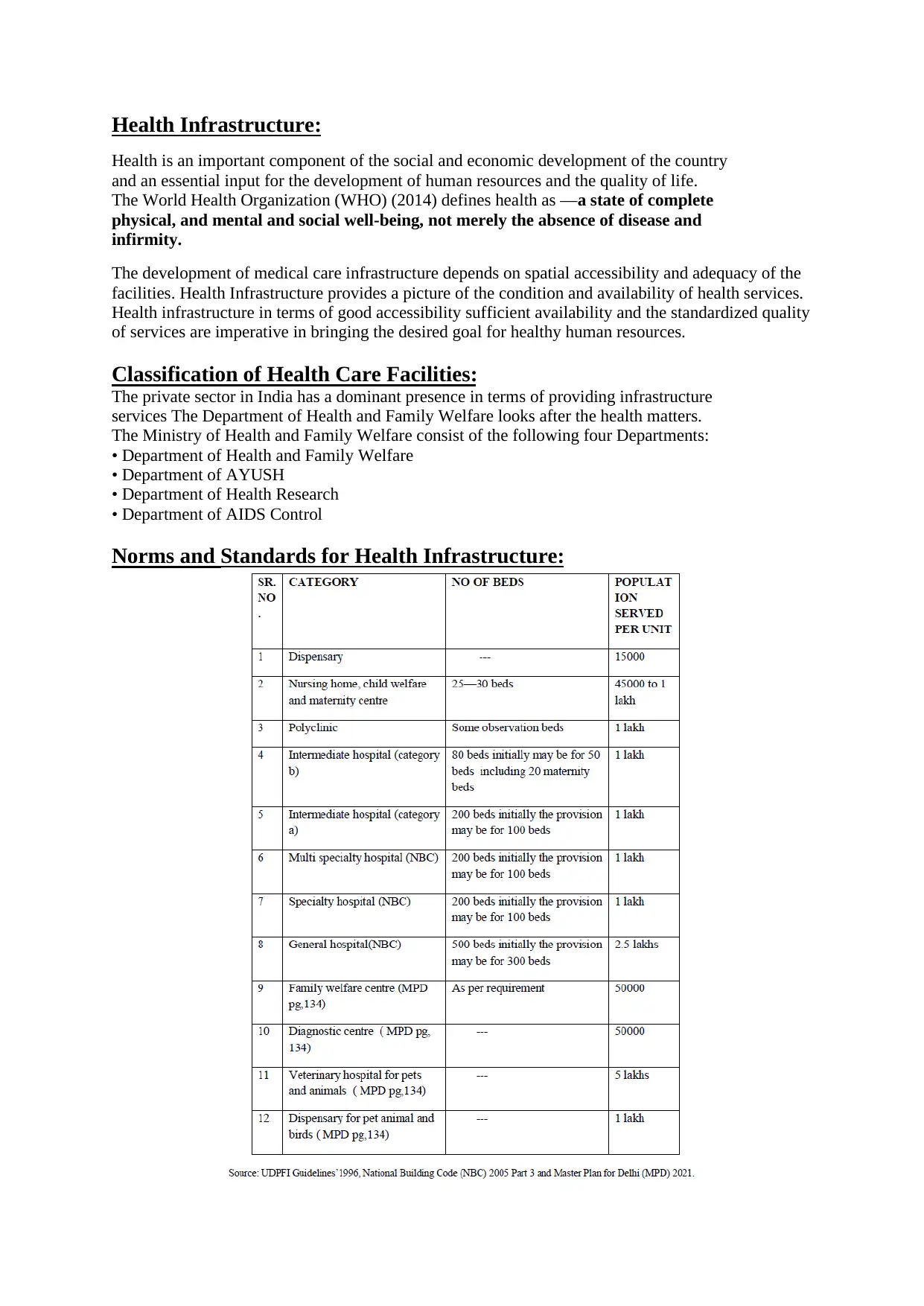
Health Infrastructure:
Health is an important component of the social and economic development of the country
and an essential input for the development of human resources and the quality of life.
The World Health Organization (WHO) (2014) defines health as ―a state of complete
physical, and mental and social well-being, not merely the absence of disease and
infirmity.
The development of medical care infrastructure depends on spatial accessibility and adequacy of the
facilities. Health Infrastructure provides a picture of the condition and availability of health services.
Health infrastructure in terms of good accessibility sufficient availability and the standardized quality
of services are imperative in bringing the desired goal for healthy human resources.
Classification of Health Care Facilities:
The private sector in India has a dominant presence in terms of providing infrastructure
services The Department of Health and Family Welfare looks after the health matters.
The Ministry of Health and Family Welfare consist of the following four Departments:
• Department of Health and Family Welfare
• Department of AYUSH
• Department of Health Research
• Department of AIDS Control
Norms and Standards for Health Infrastructure:
Health is an important component of the social and economic development of the country
and an essential input for the development of human resources and the quality of life.
The World Health Organization (WHO) (2014) defines health as ―a state of complete
physical, and mental and social well-being, not merely the absence of disease and
infirmity.
The development of medical care infrastructure depends on spatial accessibility and adequacy of the
facilities. Health Infrastructure provides a picture of the condition and availability of health services.
Health infrastructure in terms of good accessibility sufficient availability and the standardized quality
of services are imperative in bringing the desired goal for healthy human resources.
Classification of Health Care Facilities:
The private sector in India has a dominant presence in terms of providing infrastructure
services The Department of Health and Family Welfare looks after the health matters.
The Ministry of Health and Family Welfare consist of the following four Departments:
• Department of Health and Family Welfare
• Department of AYUSH
• Department of Health Research
• Department of AIDS Control
Norms and Standards for Health Infrastructure:
Paraphrase This Document
Need a fresh take? Get an instant paraphrase of this document with our AI Paraphraser
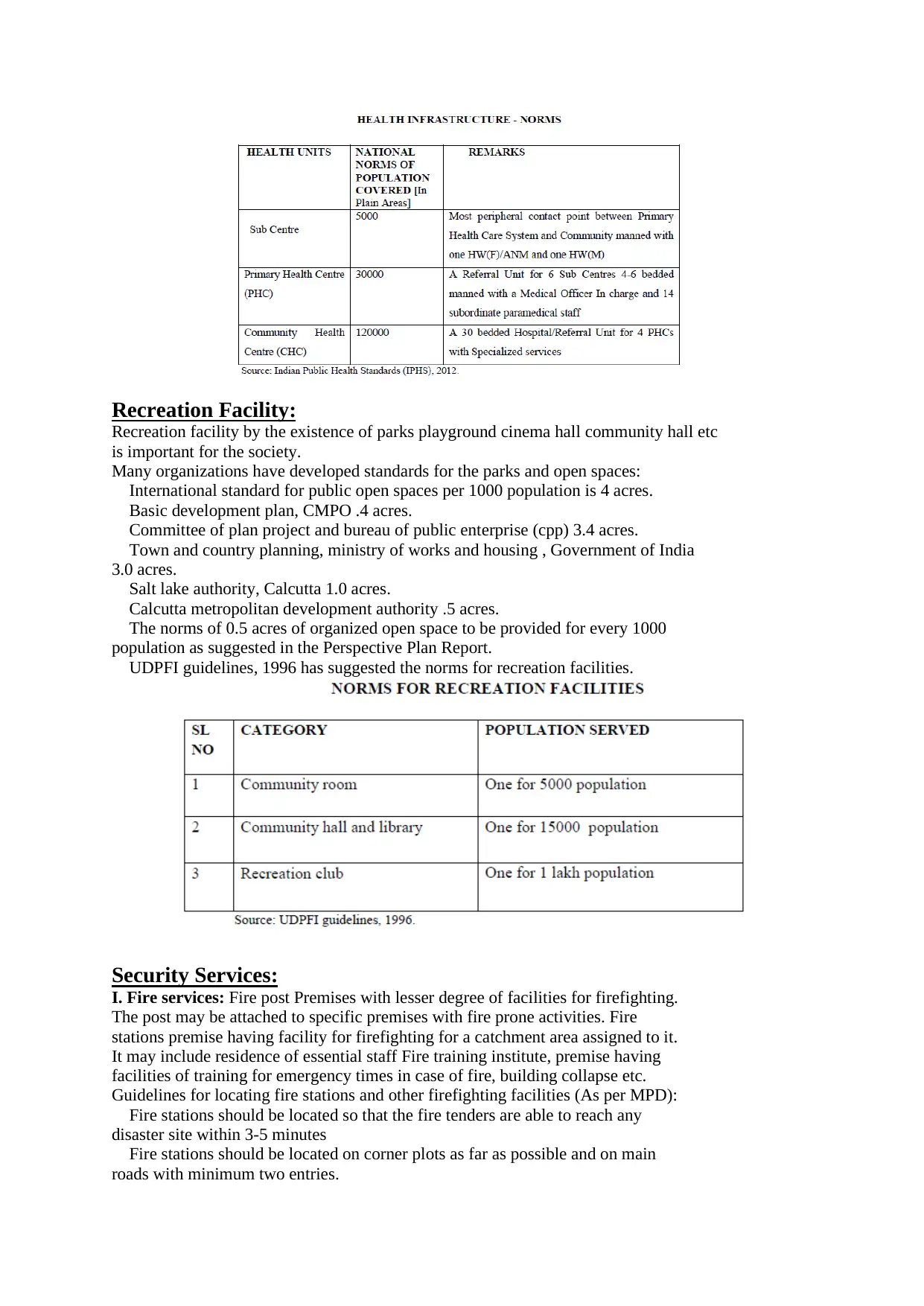
Recreation Facility:
Recreation facility by the existence of parks playground cinema hall community hall etc
is important for the society.
Many organizations have developed standards for the parks and open spaces:
International standard for public open spaces per 1000 population is 4 acres.
Basic development plan, CMPO .4 acres.
Committee of plan project and bureau of public enterprise (cpp) 3.4 acres.
Town and country planning, ministry of works and housing , Government of India
3.0 acres.
Salt lake authority, Calcutta 1.0 acres.
Calcutta metropolitan development authority .5 acres.
The norms of 0.5 acres of organized open space to be provided for every 1000
population as suggested in the Perspective Plan Report.
UDPFI guidelines, 1996 has suggested the norms for recreation facilities.
Security Services:
I. Fire services: Fire post Premises with lesser degree of facilities for firefighting.
The post may be attached to specific premises with fire prone activities. Fire
stations premise having facility for firefighting for a catchment area assigned to it.
It may include residence of essential staff Fire training institute, premise having
facilities of training for emergency times in case of fire, building collapse etc.
Guidelines for locating fire stations and other firefighting facilities (As per MPD):
Fire stations should be located so that the fire tenders are able to reach any
disaster site within 3-5 minutes
Fire stations should be located on corner plots as far as possible and on main
roads with minimum two entries.
Recreation facility by the existence of parks playground cinema hall community hall etc
is important for the society.
Many organizations have developed standards for the parks and open spaces:
International standard for public open spaces per 1000 population is 4 acres.
Basic development plan, CMPO .4 acres.
Committee of plan project and bureau of public enterprise (cpp) 3.4 acres.
Town and country planning, ministry of works and housing , Government of India
3.0 acres.
Salt lake authority, Calcutta 1.0 acres.
Calcutta metropolitan development authority .5 acres.
The norms of 0.5 acres of organized open space to be provided for every 1000
population as suggested in the Perspective Plan Report.
UDPFI guidelines, 1996 has suggested the norms for recreation facilities.
Security Services:
I. Fire services: Fire post Premises with lesser degree of facilities for firefighting.
The post may be attached to specific premises with fire prone activities. Fire
stations premise having facility for firefighting for a catchment area assigned to it.
It may include residence of essential staff Fire training institute, premise having
facilities of training for emergency times in case of fire, building collapse etc.
Guidelines for locating fire stations and other firefighting facilities (As per MPD):
Fire stations should be located so that the fire tenders are able to reach any
disaster site within 3-5 minutes
Fire stations should be located on corner plots as far as possible and on main
roads with minimum two entries.
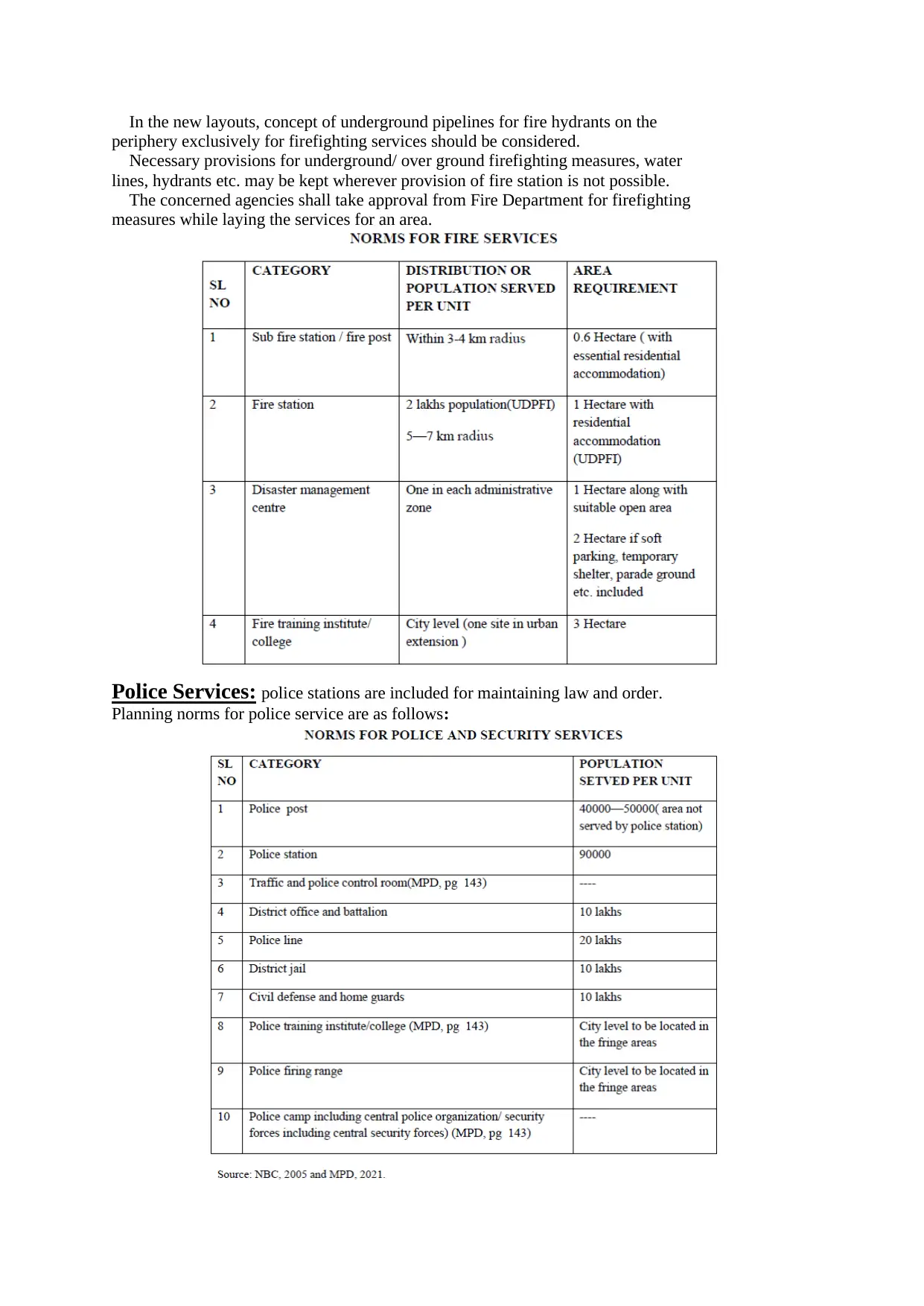
In the new layouts, concept of underground pipelines for fire hydrants on the
periphery exclusively for firefighting services should be considered.
Necessary provisions for underground/ over ground firefighting measures, water
lines, hydrants etc. may be kept wherever provision of fire station is not possible.
The concerned agencies shall take approval from Fire Department for firefighting
measures while laying the services for an area.
Police Services: police stations are included for maintaining law and order.
Planning norms for police service are as follows:
periphery exclusively for firefighting services should be considered.
Necessary provisions for underground/ over ground firefighting measures, water
lines, hydrants etc. may be kept wherever provision of fire station is not possible.
The concerned agencies shall take approval from Fire Department for firefighting
measures while laying the services for an area.
Police Services: police stations are included for maintaining law and order.
Planning norms for police service are as follows:
⊘ This is a preview!⊘
Do you want full access?
Subscribe today to unlock all pages.

Trusted by 1+ million students worldwide
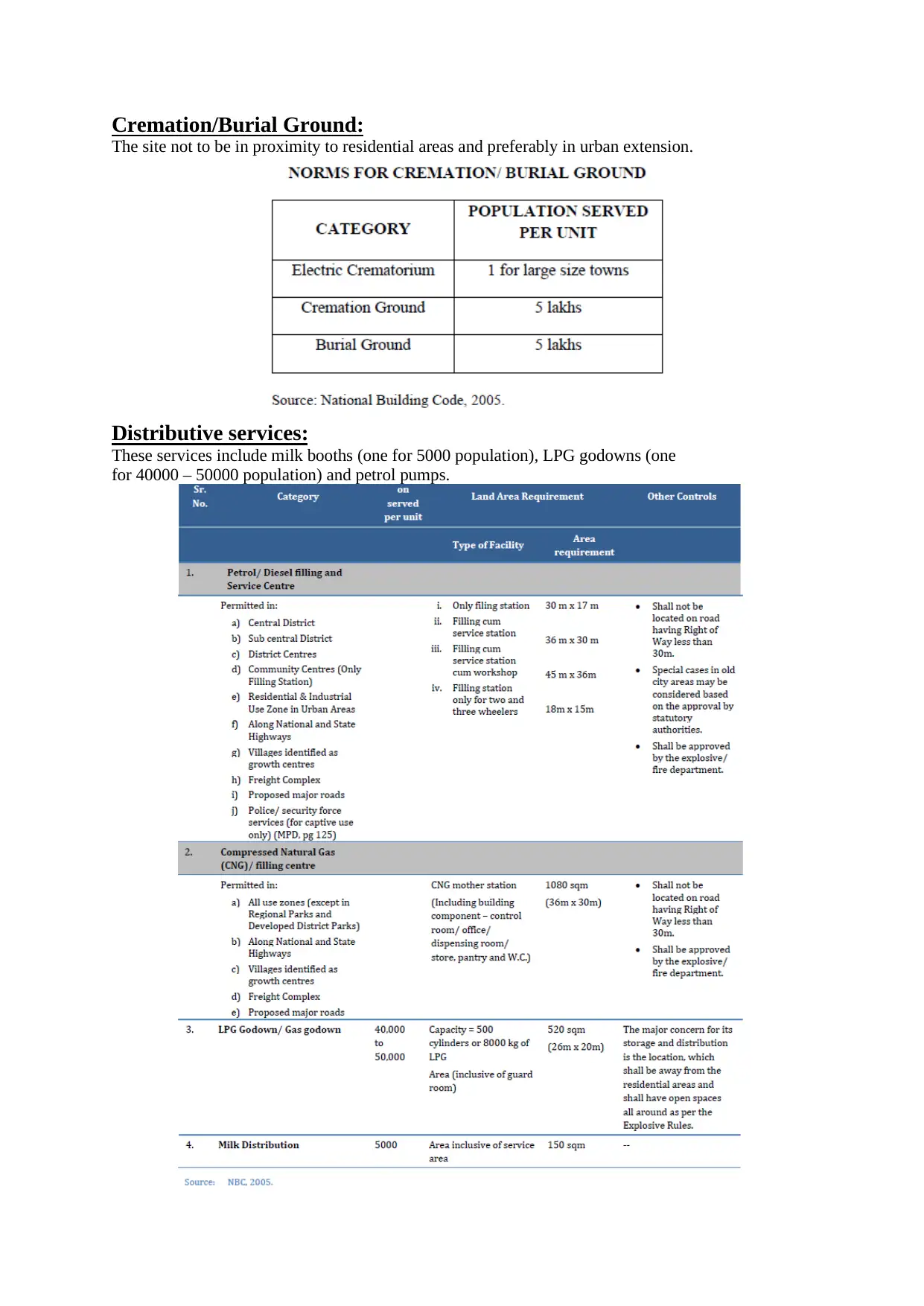
Cremation/Burial Ground:
The site not to be in proximity to residential areas and preferably in urban extension.
Distributive services:
These services include milk booths (one for 5000 population), LPG godowns (one
for 40000 – 50000 population) and petrol pumps.
The site not to be in proximity to residential areas and preferably in urban extension.
Distributive services:
These services include milk booths (one for 5000 population), LPG godowns (one
for 40000 – 50000 population) and petrol pumps.
Paraphrase This Document
Need a fresh take? Get an instant paraphrase of this document with our AI Paraphraser
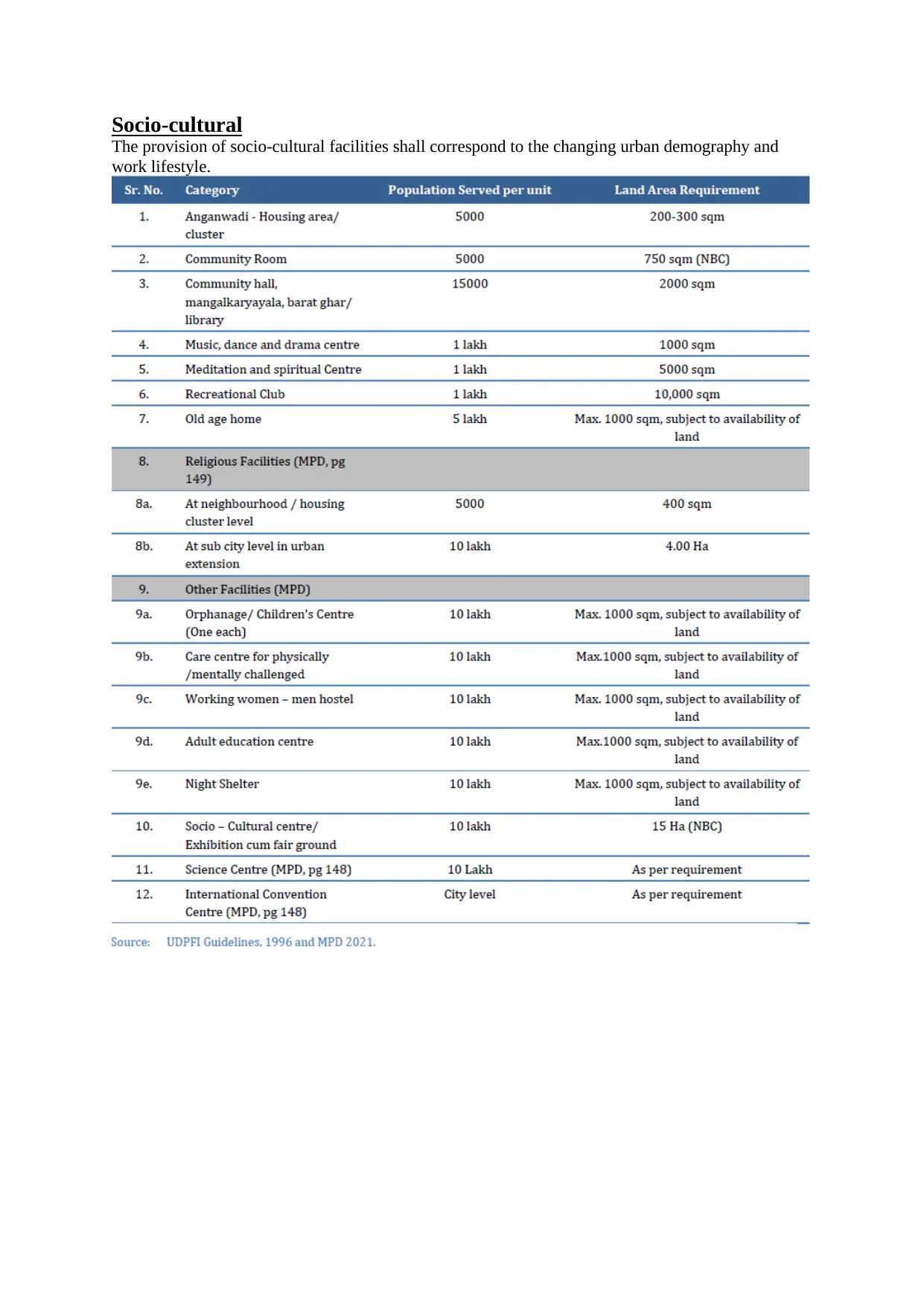
Socio‐cultural
The provision of socio-cultural facilities shall correspond to the changing urban demography and
work lifestyle.
The provision of socio-cultural facilities shall correspond to the changing urban demography and
work lifestyle.
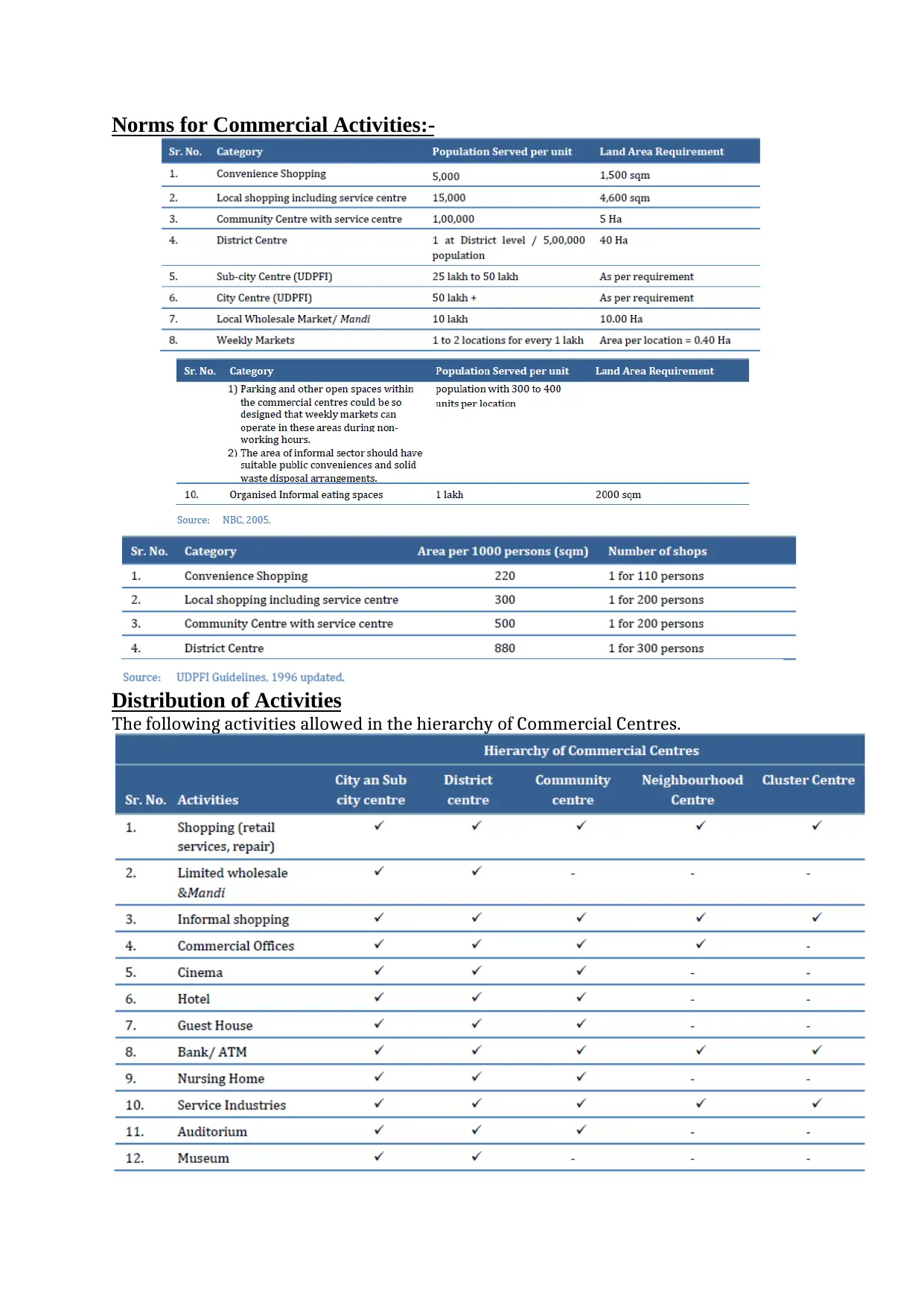
Norms for Commercial Activities:-
Distribution of Activities
The following activities allowed in the hierarchy of Commercial Centres.
Distribution of Activities
The following activities allowed in the hierarchy of Commercial Centres.
⊘ This is a preview!⊘
Do you want full access?
Subscribe today to unlock all pages.

Trusted by 1+ million students worldwide
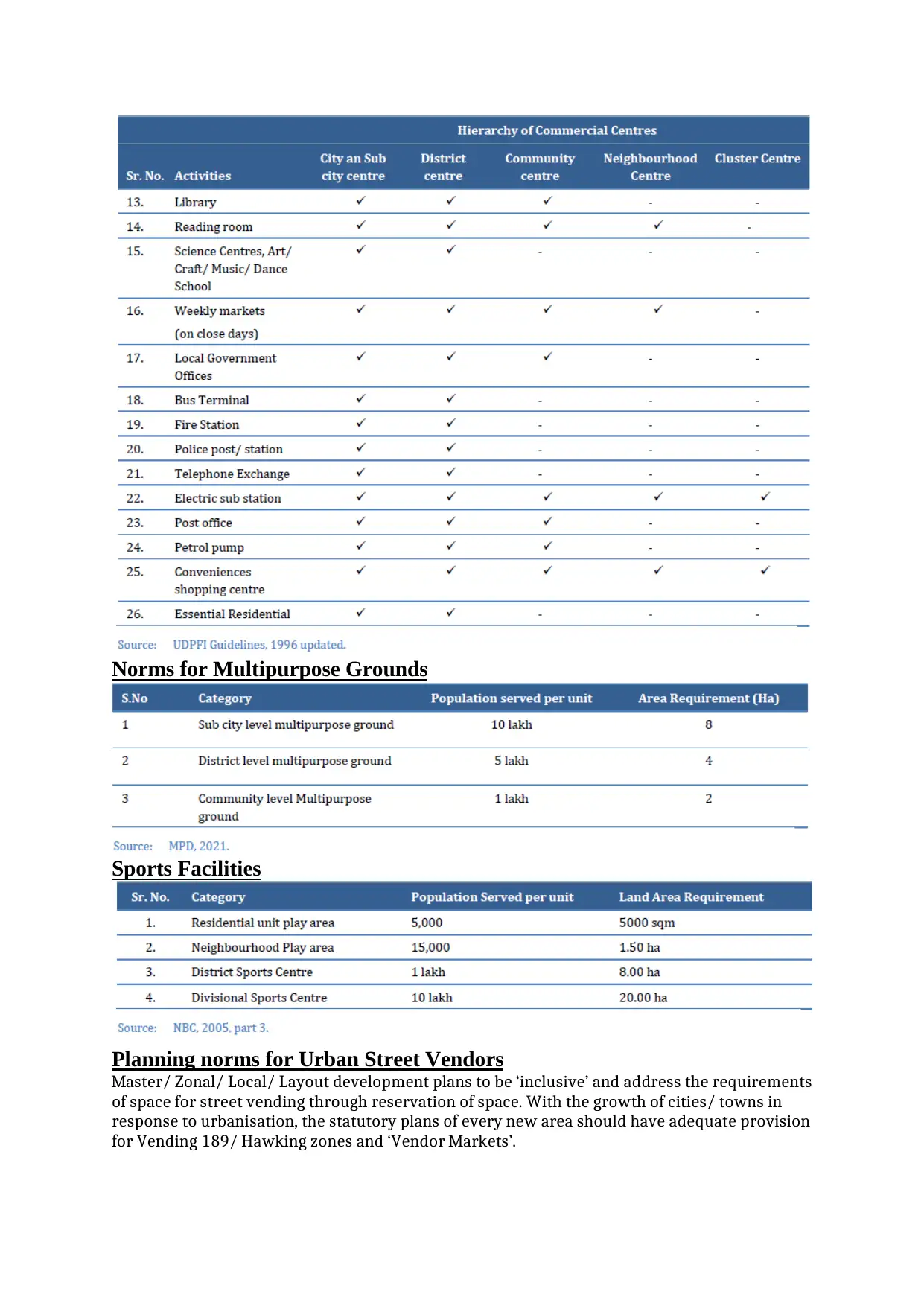
Norms for Multipurpose Grounds
Sports Facilities
Planning norms for Urban Street Vendors
Master/ Zonal/ Local/ Layout development plans to be ‘inclusive’ and address the requirements
of space for street vending through reservation of space. With the growth of cities/ towns in
response to urbanisation, the statutory plans of every new area should have adequate provision
for Vending 189/ Hawking zones and ‘Vendor Markets’.
Sports Facilities
Planning norms for Urban Street Vendors
Master/ Zonal/ Local/ Layout development plans to be ‘inclusive’ and address the requirements
of space for street vending through reservation of space. With the growth of cities/ towns in
response to urbanisation, the statutory plans of every new area should have adequate provision
for Vending 189/ Hawking zones and ‘Vendor Markets’.
Paraphrase This Document
Need a fresh take? Get an instant paraphrase of this document with our AI Paraphraser
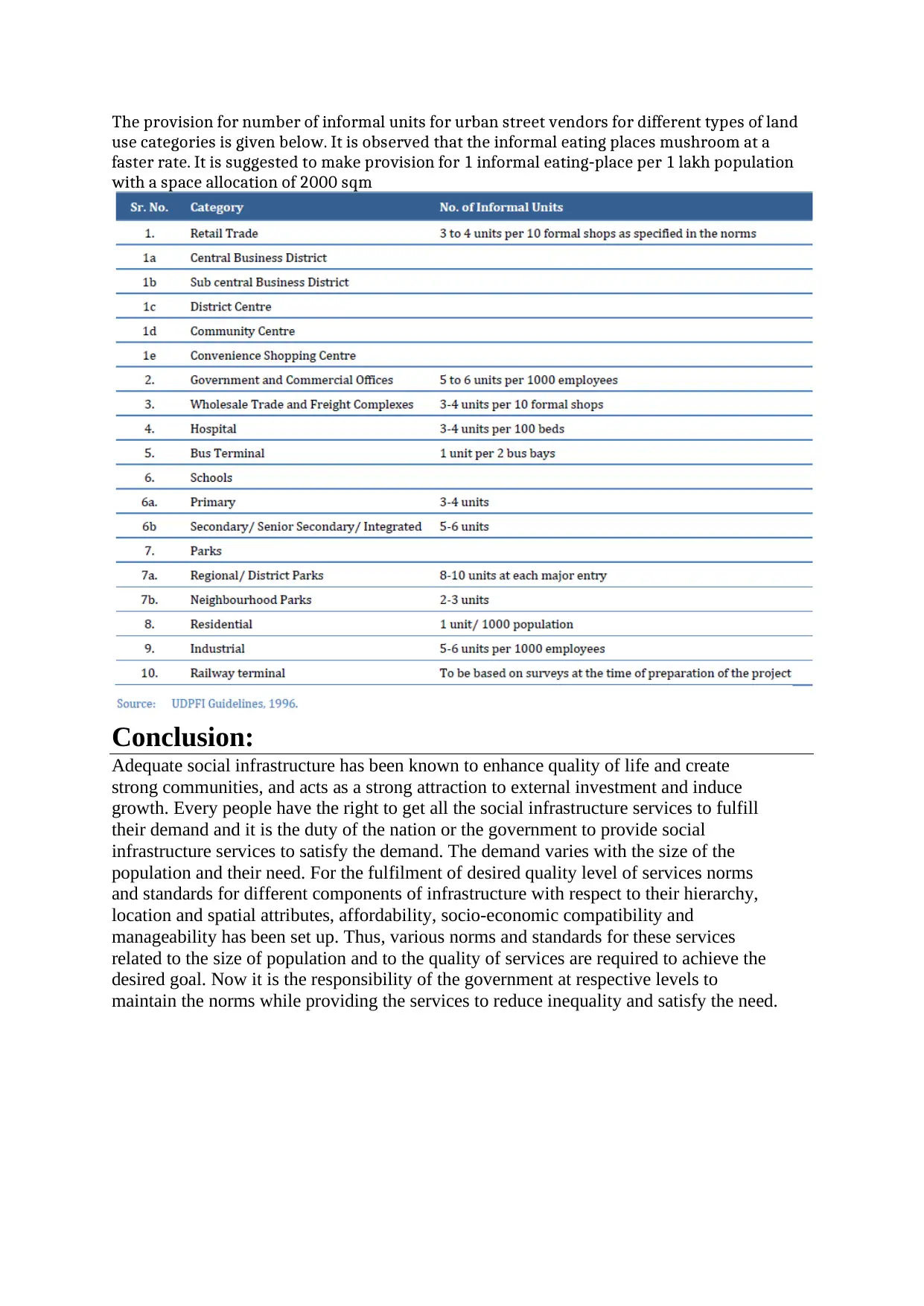
The provision for number of informal units for urban street vendors for different types of land
use categories is given below. It is observed that the informal eating places mushroom at a
faster rate. It is suggested to make provision for 1 informal eating place per 1 lakh population‐
with a space allocation of 2000 sqm
Conclusion:
Adequate social infrastructure has been known to enhance quality of life and create
strong communities, and acts as a strong attraction to external investment and induce
growth. Every people have the right to get all the social infrastructure services to fulfill
their demand and it is the duty of the nation or the government to provide social
infrastructure services to satisfy the demand. The demand varies with the size of the
population and their need. For the fulfilment of desired quality level of services norms
and standards for different components of infrastructure with respect to their hierarchy,
location and spatial attributes, affordability, socio-economic compatibility and
manageability has been set up. Thus, various norms and standards for these services
related to the size of population and to the quality of services are required to achieve the
desired goal. Now it is the responsibility of the government at respective levels to
maintain the norms while providing the services to reduce inequality and satisfy the need.
use categories is given below. It is observed that the informal eating places mushroom at a
faster rate. It is suggested to make provision for 1 informal eating place per 1 lakh population‐
with a space allocation of 2000 sqm
Conclusion:
Adequate social infrastructure has been known to enhance quality of life and create
strong communities, and acts as a strong attraction to external investment and induce
growth. Every people have the right to get all the social infrastructure services to fulfill
their demand and it is the duty of the nation or the government to provide social
infrastructure services to satisfy the demand. The demand varies with the size of the
population and their need. For the fulfilment of desired quality level of services norms
and standards for different components of infrastructure with respect to their hierarchy,
location and spatial attributes, affordability, socio-economic compatibility and
manageability has been set up. Thus, various norms and standards for these services
related to the size of population and to the quality of services are required to achieve the
desired goal. Now it is the responsibility of the government at respective levels to
maintain the norms while providing the services to reduce inequality and satisfy the need.
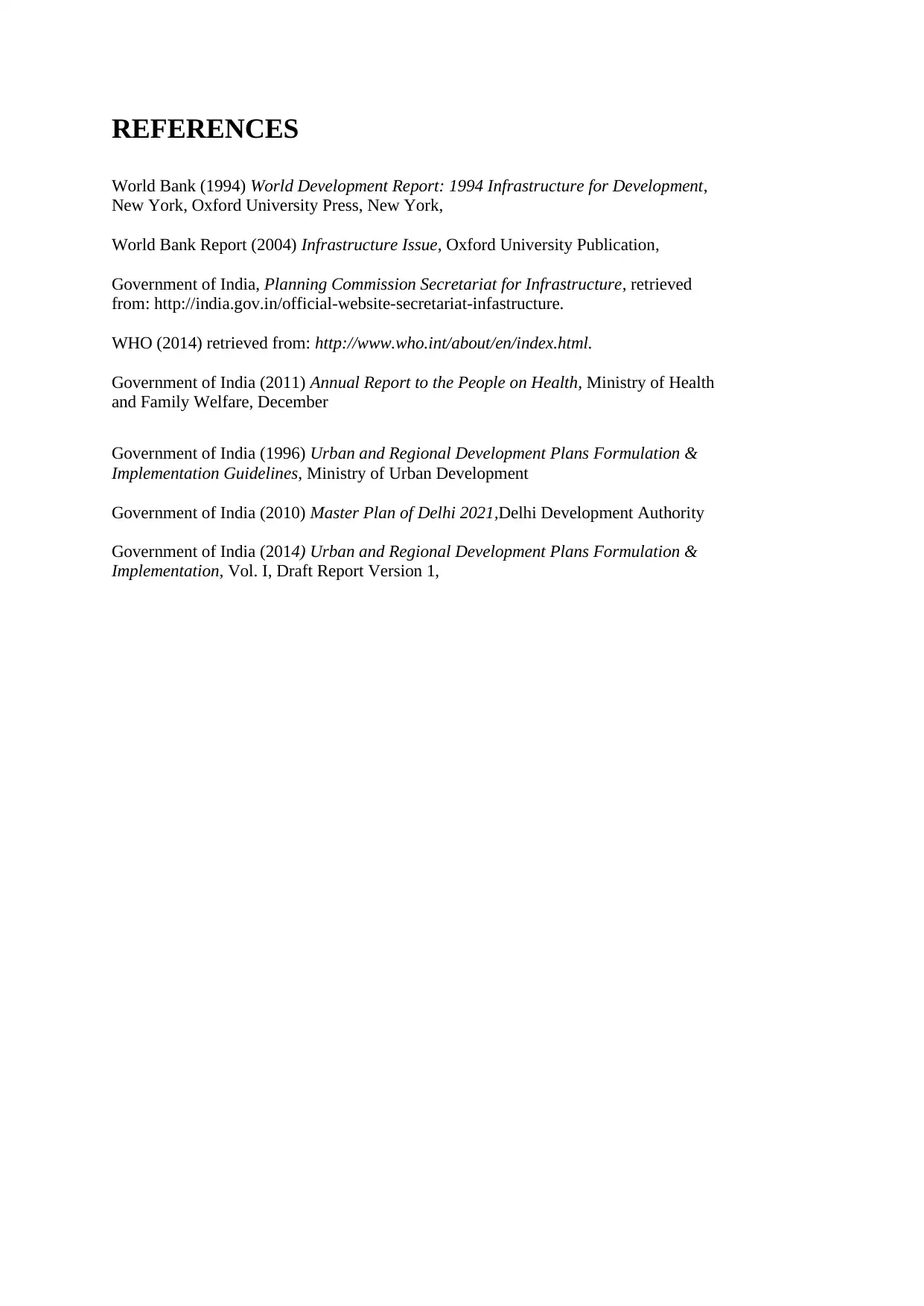
REFERENCES
World Bank (1994) World Development Report: 1994 Infrastructure for Development,
New York, Oxford University Press, New York,
World Bank Report (2004) Infrastructure Issue, Oxford University Publication,
Government of India, Planning Commission Secretariat for Infrastructure, retrieved
from: http://india.gov.in/official-website-secretariat-infastructure.
WHO (2014) retrieved from: http://www.who.int/about/en/index.html.
Government of India (2011) Annual Report to the People on Health, Ministry of Health
and Family Welfare, December
Government of India (1996) Urban and Regional Development Plans Formulation &
Implementation Guidelines, Ministry of Urban Development
Government of India (2010) Master Plan of Delhi 2021,Delhi Development Authority
Government of India (2014) Urban and Regional Development Plans Formulation &
Implementation, Vol. I, Draft Report Version 1,
World Bank (1994) World Development Report: 1994 Infrastructure for Development,
New York, Oxford University Press, New York,
World Bank Report (2004) Infrastructure Issue, Oxford University Publication,
Government of India, Planning Commission Secretariat for Infrastructure, retrieved
from: http://india.gov.in/official-website-secretariat-infastructure.
WHO (2014) retrieved from: http://www.who.int/about/en/index.html.
Government of India (2011) Annual Report to the People on Health, Ministry of Health
and Family Welfare, December
Government of India (1996) Urban and Regional Development Plans Formulation &
Implementation Guidelines, Ministry of Urban Development
Government of India (2010) Master Plan of Delhi 2021,Delhi Development Authority
Government of India (2014) Urban and Regional Development Plans Formulation &
Implementation, Vol. I, Draft Report Version 1,
⊘ This is a preview!⊘
Do you want full access?
Subscribe today to unlock all pages.

Trusted by 1+ million students worldwide
1 out of 12
Your All-in-One AI-Powered Toolkit for Academic Success.
+13062052269
info@desklib.com
Available 24*7 on WhatsApp / Email
![[object Object]](/_next/static/media/star-bottom.7253800d.svg)
Unlock your academic potential
Copyright © 2020–2025 A2Z Services. All Rights Reserved. Developed and managed by ZUCOL.

